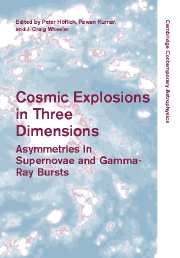Book contents
- Frontmatter
- Contents
- Part I Introduction
- Part II Supernovae: Observations Today
- Part III Theory of Thermonuclear Supernovae
- 10 Semi-Steady burning evolutionary sequences for CAL 83 and CAL 87: Super Soft X-ray binaries are supernova Ia progenitors
- 11 Type Ia progenitors: effects of spin-up of white dwarfs
- 12 Terrestrial combustion: feedback to the stars
- 13 Non-spherical delayed detonations
- 14 Numerical simulations of Type Ia supernovae: deflagrations and detonations
- 15 Type Ia supernovae: spectroscopic surprises
- 16 Aspherity effects in supernovae
- 17 Broad lightcurve SNe Ia: asymmetry or something else?
- 18 Synthetic spectrum methods for three-dimensional supernova models
- 19 A hole in Ia? Spectroscopic and polarimetric signatures of SN Ia asymmetry due to a companion star
- 20 Hunting for the signatures of 3-D explosions with 1-D synthetic spectra
- 21 On variations in the peak luminosities of Type Ia supernovae
- Part IV Theory of Core Collapse Supernovae
- Part V Magnetars, N-Stars, Pulsars
- Part VI Gamma-ray Bursts
- Part VII Conference Summary
- References
12 - Terrestrial combustion: feedback to the stars
Published online by Cambridge University Press: 11 August 2009
- Frontmatter
- Contents
- Part I Introduction
- Part II Supernovae: Observations Today
- Part III Theory of Thermonuclear Supernovae
- 10 Semi-Steady burning evolutionary sequences for CAL 83 and CAL 87: Super Soft X-ray binaries are supernova Ia progenitors
- 11 Type Ia progenitors: effects of spin-up of white dwarfs
- 12 Terrestrial combustion: feedback to the stars
- 13 Non-spherical delayed detonations
- 14 Numerical simulations of Type Ia supernovae: deflagrations and detonations
- 15 Type Ia supernovae: spectroscopic surprises
- 16 Aspherity effects in supernovae
- 17 Broad lightcurve SNe Ia: asymmetry or something else?
- 18 Synthetic spectrum methods for three-dimensional supernova models
- 19 A hole in Ia? Spectroscopic and polarimetric signatures of SN Ia asymmetry due to a companion star
- 20 Hunting for the signatures of 3-D explosions with 1-D synthetic spectra
- 21 On variations in the peak luminosities of Type Ia supernovae
- Part IV Theory of Core Collapse Supernovae
- Part V Magnetars, N-Stars, Pulsars
- Part VI Gamma-ray Bursts
- Part VII Conference Summary
- References
Summary
Abstract
This paper describes how we have used numerical simulations and laboratory combustion experiments to learn about Type Ia thermonuclear supernova explosions. We discuss detonations, deflagrations, and the transition from deflagrations to detonations, and how these relate to exploding white dwarf stars.
Introduction
This paper is for Craig Wheeler (aka Professor J. Craig Wheeler, Captain, ISS Bunbry, often stationed in the Virgo Cluster), who has been a good friend and fellow traveler for many years. Craig is wonderfully enthusiastic, persistently curious, and always asking those painfully “simple” questions for which we have no answers. He has motivated and driven research programs that have brought combustion science to astrophysics.
A cursory study of the multivolume Proceedings of the Combustion Institute shows that combustion can now be loosely defined as the result of fluid dynamics combined with exothermic reactions, and everything this implies. The definition has expanded with the understanding of the controlling phenomena and the range of applications. In the early 1900's, there was combustion and detonation, and the concepts seemed separated. Combustion was defined as oxidation with energy release, with an emphasis on specific chemical reactions. Detonation studies emphasized the fluid dynamics with shocks and explosions. Now these fields have merged and expanded. We now consider exothermic reactions, including the physics, chemistry, structure and dynamics of flames and detonations, including the production products such as pollutants, soot, diamonds, fullerenes, microparticles, and nanoparticles.
The purpose of this paper is to introduce some aspects of combustion and the combustion community to astrophysicists.
- Type
- Chapter
- Information
- Cosmic Explosions in Three DimensionsAsymmetries in Supernovae and Gamma-Ray Bursts, pp. 100 - 109Publisher: Cambridge University PressPrint publication year: 2004



